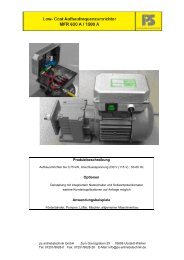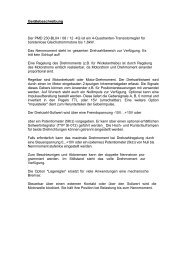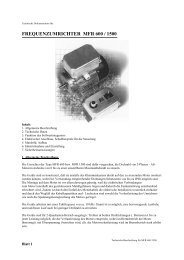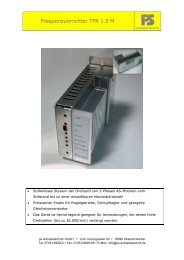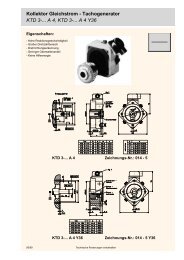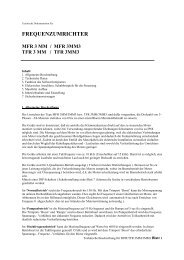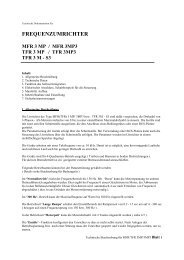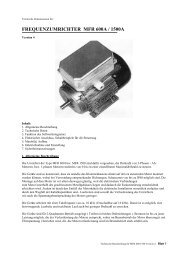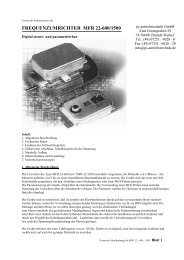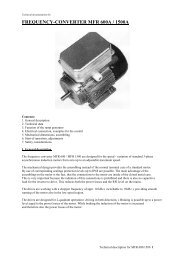frequency-converter mfr 3 mp / mfr 3mp3 tfr 3 mp / tfr 3mp3 tfr 3 m - s3
frequency-converter mfr 3 mp / mfr 3mp3 tfr 3 mp / tfr 3mp3 tfr 3 m - s3
frequency-converter mfr 3 mp / mfr 3mp3 tfr 3 mp / tfr 3mp3 tfr 3 m - s3
You also want an ePaper? Increase the reach of your titles
YUMPU automatically turns print PDFs into web optimized ePapers that Google loves.
Technical documentation for:<br />
FREQUENCY-CONVERTER<br />
MFR 3 MP / MFR 3MP3<br />
TFR 3 MP / TFR 3MP3<br />
TFR 3 M - S3<br />
Contents:<br />
1. General description<br />
2. Technical data<br />
3. Function of the ra<strong>mp</strong> generator<br />
4. Electrical connection, exa<strong>mp</strong>les for the control<br />
5. Mechanical dimensions, assembling<br />
6. Start of operation, adjustments<br />
7. Safety considerations<br />
1. General description<br />
The <strong>frequency</strong> <strong>converter</strong> MFR(TFR) 3 MP/ 3MP3; TFR 3M – S3 are designed for the speed - variation of<br />
standard 3-phase asynchronious induction motors from zero up to an adjustable maximum speed.<br />
The unit has a universal serial interface providing the connection of a control unit ( PG 1) or a bus-interface.<br />
Setting and changing of all parameters must be made by the control-unit or by the connected bus. The<br />
prameters are stored in a non volatile memory .<br />
The drives are working with a chopper <strong>frequency</strong> of appr. 10 kHz, providing smooth running of the motor also<br />
in<br />
the low speed region.<br />
The drives are designed for 4-quadrant operation ( driving and braking in both directions ).<br />
Dynamic braking requires an external braking resistor (100-220 Ohm min 50W) at terminals 9-10.<br />
The setting of the parameters include the selection of the following operation modes:<br />
In the ‘Normal - operation’ the <strong>frequency</strong> range reaches up to 150 Hz. In the low speed range the motor<br />
voltage<br />
can be increased by the setting of a boost-value ( 0…99%). The increase of the motor voltage causes at zero<br />
speed a DC-current in the motor. This DC-current provides braking down to zero speed and is automatically<br />
switched off 4 seconds after reaching zero <strong>frequency</strong>. This switch off is necessary to avoid heat-up of the motor<br />
at zero speed.<br />
In the ‘High - <strong>frequency</strong> - operation’ - mode the maximum <strong>frequency</strong> - range reaches up to 300 Hz.<br />
In the operation - mode ‘ long ra<strong>mp</strong> ‘ the ra<strong>mp</strong> - time - adjustment - range is switched from 0.2-15 sec to<br />
4 - 300 sec ( for a <strong>frequency</strong> - step of 150 Hz / 300 Hz ).<br />
The operation - mode ‘Motorpot’ enables to control the speed of the drive by 2 keys ( see 4.5 ).<br />
Selection of the ‘Enable’ – function in addition to any operation mode prevent the inverter from<br />
self – starting. After switch on or an error the inverter must be enabled by switching the enable input.<br />
The selection of the required operation - mode and the parameters must be done in the presence of mains<br />
voltage.<br />
After disconnection of the mains the parameters are stored in the non-volatile memory of the inverter.<br />
For the connections of the mains, motor and control lines there are plug - in - terminals used. To protect the<br />
drive<br />
against dust, humidity, mechanical shock and vibrations the electronic unit is embedded in a soft casting resin<br />
inside an aluminium case.<br />
Technical description for MFR/TFR 3MP/3MP3 1
The control - i<strong>mp</strong>uts of the drive are protection - isolated ( in accordance with VDE 0884 ). The drives are also<br />
protected against a direct short between motor - lines or between motor - line and earth.<br />
The electronic limiter of the motor - current allows at case - te<strong>mp</strong>eratures below 30°C a maximum motor -<br />
power of appr. 150 % of nominal power. At higher te<strong>mp</strong>eratures the maximum power is reduced to appr.<br />
120 % of nominal power at 80°C case - te<strong>mp</strong>erature. The thermal - protection is switching off the drive at appr.<br />
85°C. The reset of the thermal switch off must be done by switch off the mains for at least 10 sec.<br />
To control the drive signals from potentiometer, ext. voltage 0...10V, ext. current 0...20 mA or 4...20 mA are<br />
possible. The adaption of the input - circuit to correspond to the control - signal is made by the ju<strong>mp</strong>er B1<br />
and B2.<br />
Attention! If the input - circuit is set for control from a potentiometer or with 0...10 V, a disconnection of the<br />
control - input ( terminal 2 ) causes a control signal of half the adjusted maximum! Open control - input is<br />
therefore to be avoided.<br />
To enable the drive a closed loop must be connected to the enable - input.<br />
Control - lines with a length of more than 2 meters must be shielded. The shield should be connected to<br />
terminal 4. Below the length of 2 meters shielding is recommanded if a high disturbance - level is present in the<br />
surrounding.<br />
2. Technical data<br />
TFR/MFR 3 MP TFR/MFR 3 MP 3<br />
Mains - voltage 230 V AC 400 V AC<br />
(115 V AC a.A.)<br />
Tolerance of the mains-voltage +-15 % +-15 %<br />
Frequency of the mains-voltage 50 - 60 Hz 50 - 60 Hz<br />
recommanded fuse in the mains 16 A slow 10 A slow<br />
rec. max. motor size 1.5 k W 1.5 k W<br />
Nominal voltage of the motor 3X230 V AC 3X400 V AC<br />
Motor - current ( max. at 30°C case-te<strong>mp</strong>.) 12 A eff 6 A eff<br />
( max. at 80°C case-te<strong>mp</strong>.) 8 A eff 4 A eff<br />
Te<strong>mp</strong>erature - range ( case - te<strong>mp</strong>erature ) 0 - 80°C 0 - 80°C<br />
Mechanical size mm 155 X 80 X 205 155 X 80 X 205<br />
Weight kg 1.5 1.5<br />
Output - <strong>frequency</strong> - ranges:<br />
- Normal - operation 0 - 150 Hz<br />
- High - <strong>frequency</strong> - operation 0 - 300 Hz<br />
Adjustment - range of the min. <strong>frequency</strong> 0...100% of the preadjusted maximum<br />
Ra<strong>mp</strong> - times:<br />
Normal - operation, <strong>frequency</strong> - step = 150 Hz<br />
- with short ra<strong>mp</strong>e 0.2 - 15 sec<br />
- with long ra<strong>mp</strong>e 4 - 300 sec<br />
High - <strong>frequency</strong> - mode, <strong>frequency</strong> step = 300 Hz<br />
- with short ra<strong>mp</strong>e 0.2 - 15 sec<br />
- with long ra<strong>mp</strong>e 4 - 300 sec<br />
Control - signals:<br />
B1 and B2 open Poetentiometer or ext. voltage 0...10 VDC<br />
B1 closed, B2 open 0 - 20 mA<br />
B1 and B2 closed 4 - 20 mA<br />
Technical description for MFR/TFR 3MP/3MP3 2
Input - resistance of the control - input:<br />
B1 open > 500 kohm<br />
B1 closed 470 ohm<br />
Enalble - signal: closed loop , 10V / 1 mA DC<br />
Reversing - signal: open / closed loop, 10 V / 1 mA DC<br />
Te<strong>mp</strong>eratur protection input: closed loop with R < 1040 ohm<br />
(not for TFR 3M – S3) Loop current appr. 1 mA<br />
Inverter OK – output : open collector NPN,<br />
max. load 27V DC / 100 mA<br />
Rec. brak-resistor: 100 Ohm/150 W 220 Ohm/150 W<br />
3. Function of the ra<strong>mp</strong> generator<br />
3.1 Normal - or high - <strong>frequency</strong> - operation - mode<br />
Sollwert<br />
set-value<br />
Frequenz<br />
(Drehzahl)<br />
speed<br />
ta td Zeit / time<br />
Technical description for MFR/TFR 3MP/3MP3 3
4. Electrical connection, exa<strong>mp</strong>les for the control<br />
4.1 Control by potentiometer:<br />
(MFR/TFR 3MP/3MP3)<br />
8<br />
7<br />
6<br />
5<br />
M-te<strong>mp</strong>.<br />
Direction<br />
Enable<br />
4.2 Control by potentiometer:<br />
(TFR 3M – S3)<br />
4 5 6<br />
enable<br />
direction<br />
4<br />
2 3<br />
3<br />
1<br />
set-point<br />
2<br />
1<br />
set-point<br />
Inverter OK<br />
Inverter OK<br />
9 10<br />
9 10<br />
U V W PE<br />
Break-R<br />
100 ohm<br />
150 W<br />
Break-R<br />
100 ohm<br />
150 W<br />
U V<br />
M 3 PH<br />
3x230V<br />
3x400V<br />
W<br />
M 3 PH<br />
3x230V<br />
PE<br />
PE<br />
N<br />
L<br />
Mains<br />
230V/115V<br />
400V<br />
Switsch<br />
230V/115V<br />
Mains<br />
230V/115V<br />
4.3 Control by external voltage 0...10 V DC: 4.4 Control by external current 0...20 mA DC ( 4 ... 20<br />
mA DC ):<br />
6 7 8<br />
M-te<strong>mp</strong>.<br />
Direction<br />
Enable<br />
2 3 4 5<br />
+<br />
-<br />
1<br />
=<br />
external control<br />
voltage 0 - 10V DC<br />
Inverter OK<br />
4.5 Control by 2 keys in the mode ‘Motorpot’:<br />
8<br />
7<br />
6<br />
5<br />
M-te<strong>mp</strong>.<br />
Direction<br />
Enable<br />
4<br />
3<br />
2<br />
1<br />
control keys<br />
+ key<br />
- key<br />
Inverter OK<br />
8<br />
7<br />
6<br />
5<br />
M-te<strong>mp</strong>.<br />
Direction<br />
Enable<br />
4<br />
3<br />
2<br />
+<br />
-<br />
1<br />
=<br />
external control<br />
current<br />
0...20mA DC (B1 closed,B2<br />
open)<br />
4...20mA DC (B1 and B2<br />
closed)<br />
Inverter OK<br />
Technical description for MFR/TFR 3MP/3MP3 4
5. Mechanical dimensions<br />
5.1 TFR:<br />
120<br />
5.2 MFR:<br />
202<br />
Upper part with the inverter<br />
Lower part<br />
Range for cableterminations<br />
Motor<br />
Sealing<br />
Sealing<br />
80<br />
143<br />
155<br />
5<br />
Technical description for MFR/TFR 3MP/3MP3 5
Assembling - steps:<br />
(MFR only)<br />
1. Drilling and milling of the lower part of the case in accordance to the flange of the motor - terminal - case.<br />
Drilling the holes for the cable - terminations.<br />
Caution! Take care that the capacitors of the drive do not bu<strong>mp</strong> into the terminals of the motor!<br />
2. Assembling of the lower part of the case on the motor.<br />
3. Assembling of the cable - terminations.<br />
4. Assembling and fastening of the cables.<br />
5. Connecting of the plug-in - terminals to the wires of the cables and the motor.<br />
6. Placing the seal.<br />
7. Plug - in the connectors to the <strong>converter</strong>.<br />
9. Fixing of the upper case on the lower case.<br />
6. Start of operation, adjustments:<br />
It is recommanded to make the requ. adjustments within the incoming inspection.<br />
For OEM applications we offer as a special service without additional costs to make the adjustments within the<br />
final inspections in our house.<br />
6.1 Position of the ju<strong>mp</strong>ers:<br />
Selection of the control modes:<br />
Ju<strong>mp</strong>er<br />
B1<br />
B2<br />
Control by potentiometer or ext. Voltage 0…10V: B1 and B2 open<br />
Control by current 0…20 mA: B1 closed, B2 open<br />
Control by current 4…20 mA: B1 and B2 closed<br />
Technical description for MFR/TFR 3MP/3MP3 6
7. Safety considerations<br />
The following safety considerations must be observed during all phases of operation, service and repair of this<br />
device. Failure to co<strong>mp</strong>ly with this precautions violates the intended use of this device.<br />
To minimize the shock - hazard the drive must be connected to an electrical ground. Terminal PE or the metalcase<br />
must be connected to the electrical ground ( safety - ground ) of the power - outlet.<br />
Do not operate in an explosive atmosphere!<br />
Operation of this device in the presence of flammable gases, fumes or dusts may cause of an ignition of this<br />
atmosphere and is to prevent.<br />
CAUTION!<br />
To prevent potential shock hazards do not expose this device in the open state to moisture, rain or wetness.<br />
Wetness inside the case may cause an electrical connection between mains and the inputs.<br />
Installation, ajustment and service of this device must be made by qualified personal. Works at the electrical<br />
parts of the device are very dangerous because of the high voltage the device is working with. This high voltage<br />
is capable of causing death and is present even after disconnecting mains. Before starting of service it is<br />
necessary to wait at least 30 sec. after disconnecting mains.<br />
This device must not used as an electrical disconnection. It is not allowed to work at the output lines without a<br />
mechanical disconnection from mains, even if the driven motor does not carry voltage or current.<br />
Do not atte<strong>mp</strong>t internal service or adjustment unless another person, capable of disconnecting mains and<br />
rendering first aid is present.<br />
Do not touch the electrical parts of this device. During operation the electrical parts are carrying dangerous<br />
voltages. Out of operation a touch may cause a defect by electrostatic discharge.<br />
To prevent additional hazards, do not make modifications at this device.<br />
It is not allowed to use this unit in security or emergency-applications. Misfunction of the connected motor at<br />
active mains can not be ruled out .<br />
Version: 1.0<br />
Datum: 21.08.2006<br />
Technical description for MFR/TFR 3MP/3MP3 7



